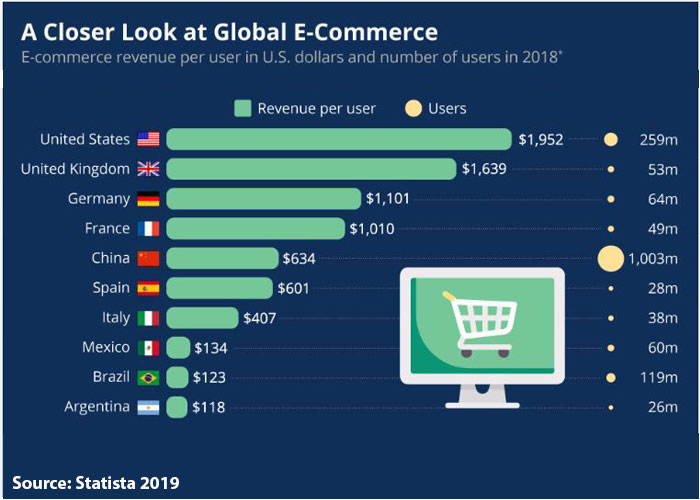
The E-Commerce websites and portals have created an unprecedented revolution in the world. More users are now buying stuff online than ever. According to Statista, China alone boasts of more than 1 billion ecommerce shoppers. This is more than the population of any other country barring India & China. US is second in terms of ecommerce shoppers around the world.

US has over 259 million ecommerce shoppers, but ranks highest in terms of revenue per user. On an average every ecommerce shopper spent $1,952 in US in 2018. UK comes close behind the US with an average spending of $1,639. Interestingly UK only has $53 million ecommerce users. Germany ranks third with an average spending of $1,101 per users. It has 64 million users. Germany has the largest number of ecommerce shoppers in Europe.

France is fourth on the list and the last one where the average spending was over $1,000. France currently has an ecommerce user base of 49 million and revenue per user $1,010. China follows France with an average spending per user of $634. China has a mind boggling 1,003 million ecommerce users. No wonder China has some of the largest ecommerce companies on the planet including JD Inc, Alibaba and Tencent among others.
Spain is next on the list with average revenue per user of $601. It has a user base of 28 million currently. As per Spain government’s official figures, the internet penetration is 85%. Italy ranks seventh in the global revenue per user with $407 per user. It has 38 million ecommerce shoppers currently. The European Union makes it easier to sell ecommerce products across Europe increasing the consumer base.
Mexico ranks eighth in the ecommerce spending per user spending of $134. Mexico has 60 million ecommerce shoppers. Brazil and Argentina round of the ninth and tenth spots on the highest revenue per users list globally. Brazil has 119 million users and per user spending of $123. Argentina has the lowest number of ecommerce shoppers among this list. It has 26 million users and average spending of $118.

The ecommerce markets around the world continue to grow at rapid pace. The penetration of smart phones has augmented the growth of mcommerce in countries like China and around the world. Logistics is also playing a key role in enabling ecommerce growth. With Amazon prime service, the swift delivery of ecommerce goods is bringing in more users. The advanced digital technologies and widespread use of software platforms for user analysis, marketing, analytics and AI is also pushing ecommerce growth in various markets.
The global ecommerce market is expanding rapidly and more users are being added to it every passing minute. As per IBEF, India is the fastest growing market in the ecommerce sector growing at 51% annually. New industries are being disrupted by the ecommerce revolution. The online platforms for selling goods and services are increasingly preferred by users today.

The ecommerce market has generated an ecosystem where consumers are able to purchase international brands and products with ease. It is also generating export opportunities for suppliers and vendors. Many businesses are tapping into digital business opportunities for growing and scaling their reach.
The ecommerce market is also creating millions of jobs around the world in building software platforms, operations, logistics, warehousing and technological innovations. The online trading platforms are primarily driven by software as a service delivery model, powered by advanced analytics, data and cloud based infrastructure.

The ecommerce phenomenon has emerged as a strong force, which has shaken up the world’s biggest retailers and industries. The push to bring more offline services, vendors to the ecommerce bandwagon will see greater technological adoption. The mushrooming of services aggregators, online marketplaces and ecommerce portals across various industries and sectors is expected to bring transformational changes in our day to day lives.







